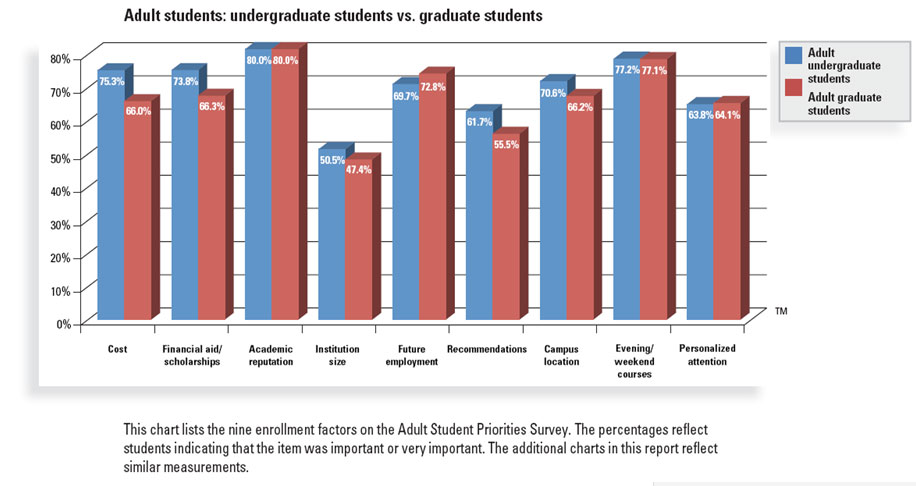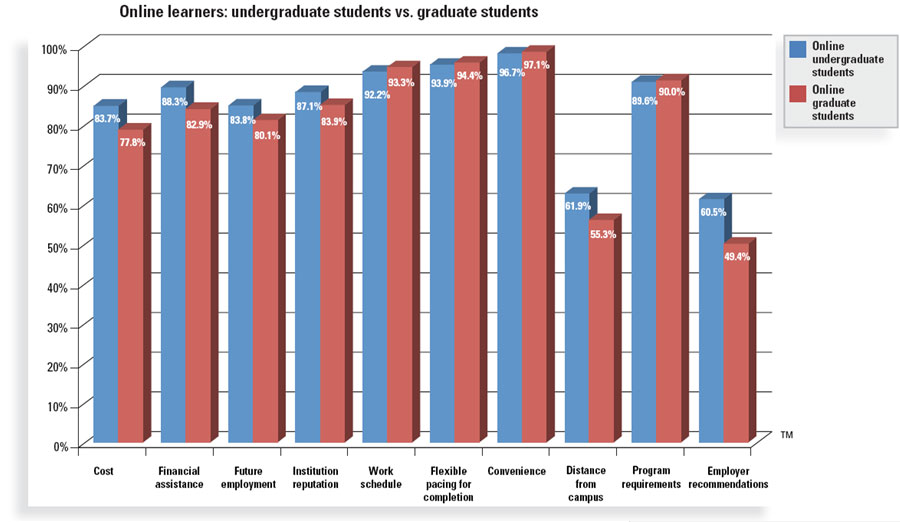enrollment
What influences nontraditional student enrollment?
In May, I wrote about the driving factors influencing traditional student enrollment decisions. We now have data available on which enrollment factors are critical to nontraditional students, including online learners and students 25 and older.
Every year, hundreds of campuses administer the Adult Student Priorities Survey™ (ASPS) to their adult undergraduate and graduate students and the Priorities Survey for Online Learners™ (PSOL) to students enrolled in online programs. In addition to the items rated for importance and satisfaction on the general student experience, both the ASPS and PSOL include items that address factors in a student’s decision to enroll (nine items on the ASPS and ten items on the PSOL). The 2012 national research report The Factors Influencing College Choice Among Nontraditional Students focuses on data from more than 5,500 students and 17 public and private four-year institutions that completed the ASPS and 17,000 online learners from 16 institutions that completed the PSOL during just the fall of 2011. There is special emphasis in this report on the different perceptions of undergraduate and graduate students in both data sets.

The most important factor for both populations is the academic reputation of the institution, followed closely by the availability of evening or weekend courses. Undergraduate students placed a greater level of importance on several factors, including cost and financial aid, while graduate students placed a slightly higher importance on future employment opportunities in their decision making.

Convenience was the number-one factor cited by both online undergraduate and graduate students, followed closely by flexible pacing and work schedule. Once again, undergraduate students placed a higher priority on cost and financial aid than graduate students did, while graduate students did not have any factors that were significantly more important to them than they were to undergraduate students.
The full enrollment factors report explores the data further by comparing perceptions of adult students who indicated that they were at their first-choice institution versus those who perceived themselves to be at their second- or third-choice institution.
What do these results signify for campus professionals? The results suggest four priority action items:
- Use your academic reputation to express the value of your educational offerings. As with traditional students, adult and online learners need to know that an education from your institution is worth the investment. Making the strengths, features, benefits, and outcomes of your academic offerings clear will go a long way toward helping prospective students decide to enroll with you, as well as convincing current students to persist and graduate. Your faculty and staff should also express your institution’s academic excellence in their interactions with students.
- Emphasize the convenient benefits of your adult-serving programs. Nontraditional students are often juggling multiple responsibilities such as work and home along with coursework. They place a premium on the convenience of your course offerings, whether through evening and weekend courses or with the 24/7 accessibility of online courses. Be mindful of these priorities as your institution develops and promotes the undergraduate and graduate courses you offer.
- Prospective and current students want to know how much their educations will cost. This is true for both traditional and nontraditional populations. Your Web site and other campus communications should make this information accessible. If you are changing tuition, communicate this clearly to current students, as well as why tuition is changing and how students will benefit from the change. Be sure to make full use of federally mandated tuition calculators to provide complete, current information to prospective and current students on your Web site.
- Make financial aid information easy to obtain. While financial aid may not motivate a nontraditional student to select your institution as much as it may motivate a traditional student, adult and online learners are still very aware of how a financial aid package makes the educational experience possible. Information on all financial resources, including scholarships, is important to help nontraditional students know that they can afford to enroll at your institution.
In addition, while adult students often have higher expectations in other areas that influence enrollment, they still place a value on personalized attention prior to enrollment. Delivering personalized attention at every point of contact—in the mail, online, over the phone, and on campus—can make a big difference in persuading a student to enroll and to persist. It’s also an area where your campus has a unique opportunity to differentiate itself from other institutions.
Tell students what it will cost, what financial assistance will be available, the value of your educational offerings, and the convenience you offer, and you address the top four elements that impact enrollment decisions.
What factors do you find influence the enrollment decisions of your nontraditional students? What methods have you found to attract adult and online learners to your institution? Send me an e-mail or leave a comment.
In my next blog post, I will share the current findings on priority issues for improvement to nontraditional students once they have enrolled.
